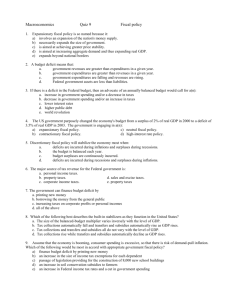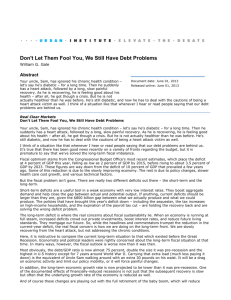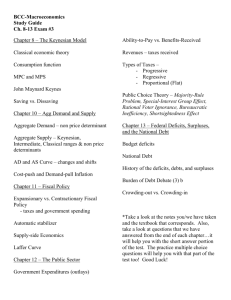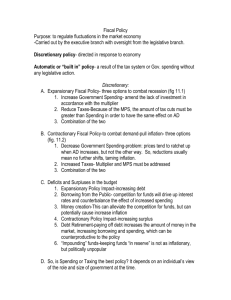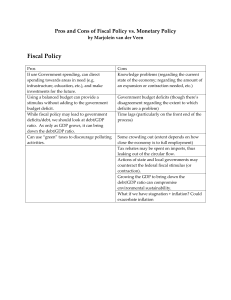New logo in yellow - Queen's Economics Department
advertisement
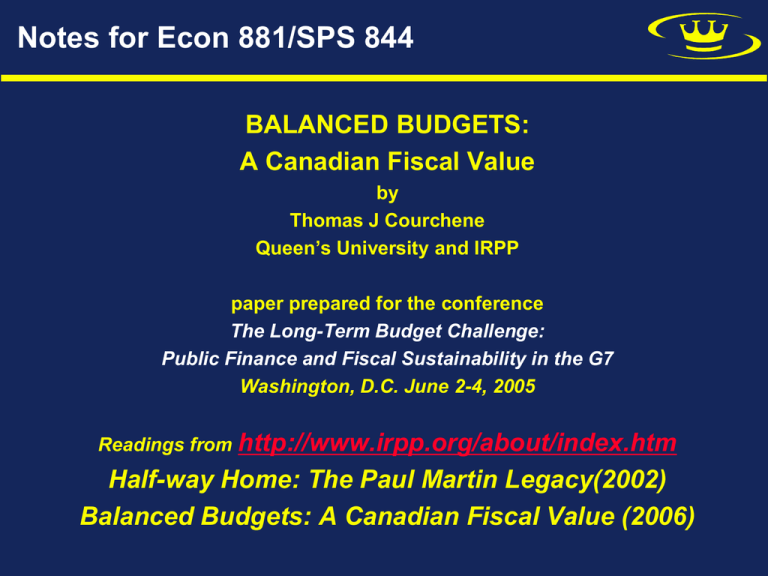
Notes for Econ 881/SPS 844 BALANCED BUDGETS: A Canadian Fiscal Value by Thomas J Courchene Queen’s University and IRPP paper prepared for the conference The Long-Term Budget Challenge: Public Finance and Fiscal Sustainability in the G7 Washington, D.C. June 2-4, 2005 Readings from http://www.irpp.org/about/index.htm Half-way Home: The Paul Martin Legacy(2002) Balanced Budgets: A Canadian Fiscal Value (2006) Balanced Budgets Overview Anatomy of the Deficit and Debt Explosion Taming the Deficits Processes Policy Sustaining the Public Pension System Allocating Budget Surpluses Provincial Fiscal Challenges Long Term Sustainability? CANADA’S FISCAL TURNAROUND A: Overview 27 consecutive federal deficits prior to 1997, with a peak deficit of $42 billion in 93/94 A surplus in 97/98 followed by six consecutive surpluses with a further one forecast for 04/05 Federal debt-to-GDP ratio that rose from under 20% in early 1970s to 68.4% in 95-96, second only to Italy in G7. Total federal and provincial debt exceeded 100% in mid-1990s Federal debt-to-GDP ratio falls to under 40% in 2004-05, down about 30 percentage points from 95/96 and still falling. Forecast to be 25% within a decade Canada sets its contributory public pension system on a long-term sustainable basis. Business Week calls this the Maple Leaf Miracle, The Economist calls Canada the Fiscal Virtuoso of the G7 In international circles, a balanced budget is sometimes referred to as a “Canadian fiscal value,” B: Anatomy of the Debt/Deficit Explosion Some Unpleasant Fiscal Arithmetic (Chart 2) D/GDP will fall if OB/GDP > (i-g)(D/GDP) Where OB is operating balance, i = nominal interest rate, and g = nominal growth rate For Canada, post war to early 1970s g-i>0 and OB/GDP >0, therefore D/GDP falls for 2 reasons. This is a “golden era of fiscal policy” After mid 1970s, both begin to turn negative and deficits and debt explode. Must be also true globally, so that this one reason for the generality of the fiscal explosion. More recently, close to being back into a golden era, at least for Canada This chart appeared in a Finance Canada publication in 1994 to convince Canadians that they had to accept large operating surpluses in order to control deficits and debt. As chart 2 shows, OB/GDP has been high, reaching 6% at one point. B: Anatomy of the Debt/Deficit Explosion: II Factors Underpinning The Fiscal Dynamics International Energy Price Spike 73/74 Floating Rates and Soft Budget Constraints Canada Specific Inflation indexing Bank of Canada’s 1988 Conversion to Price Stability CANADA’S FISCAL TURNAROUND B: Taming the Deficit: Targets The decisive initiative was the publication in the 1995 budget of federal DEFICIT TARGETS: 1995-56 $32.7 billion or 4 % 0f GDP 1996-97 $24.3 billion or 3% of GDP 1997-98 $17.0 billion or 2% of GDP 1998-99 $ 9.0 billion or 1% of GDP Budget balance thereafter Finance Minister Paul Martin claimed he would achieve these targets “come hell or high water” To ensure success, Martin radically altered both fiscal policy and the budgetary process Indeed, as we shall see budget balance was achieved two years in advance (1997-98) so that the $9 billion deficit target for 1998-99 was then set to zero. B: TAMING THE DEFICIT: II Increasing the Reliability of Budget Forecasts Finance abandoned five-year forecasts. Instead, it focused on the current year and the following two Invited private sector firms to submit forecasts of key variables (nominal and real GDP, unemployment rates, exchange rates, etc). Finance then developed average or “consensus” forecasts from these submissions Finance then converts these consensus forecasts to prudent forecasts. For example, 1999 consensus forecasts were 2.7%, 4.4%, and 5.1% for GDP growth, t-bills and 10 year bonds respectively. Prudent forecasts were 2.5%, 5.1% and 5.6% Finance then uses these prudent forecasts to generate revenues and expenditures consistent with the target. This builds in a degree of safety or prudence B: TAMING THE DEFICIT: III The Contingency Reserve To further ensure that targets will be met, Finance added a contingency reserve, set at $3 billion per year. This contingency reserve appears as an expenditure that is built into the deficit target. This is an additional $3 billion cushion in case the budget revenue projections turn out to be too high If the projections are accurate, and the contingency reserve is not needed to achieve balance, it must go to debt reduction—it cannot be spent on programs In the 1999 budget, Finance noted that this $3 billion contingency reserve would offset the combined effect of a 1% shortfall (from forecast) of nominal GDP and a 100 basis point underestimate of interest rates. TAMING THE DEFICIT: IV Fiscal Policy Measures The 1995 budget cut transfers to the provinces by $6 billion on an annual basis by 1998 (much of this was restored in the later era of surpluses) The 1995 budget also trimmed the federal civil service by 50,000 persons (25%), largely through attrition A program review led to an overall decrease in program spending of 10% Finance “captured” $6 billion of excess employment insurance premiums and applied them to deficit reduction. This continued for almost a decade. As a result, the provinces were put under severe fiscal restraint, but the times were good and they also achieved budget balance by 2000. However, they are now much more vulnerable fiscally than is Ottawa. B: TAMING THE DEFICIT : V With the wind at Paul Martin’s back… Paul Martin’s chief opposition came from the Reform Party, who were even more fiscally conservative; Moody’s put Canada under a “credit watch” in early 1995, which helped Martin carry the political day; The exchange rate fell from 89 US cents in 1991 to the low 70 cent range by 1995 (exports mushroomed); Bank of Canada’s inflation targeting brought average inflation to 1.8% over the last decade providing much relief on the debt servicing side. Both Finance and the Bank agree on the 1-3% target range; The US was in the midst of its longest and strongest post-war economic boom, so that GDP tended to grow beyond the forecast rates; Hence, Martin had some important help and luck in his mission to tame Canada’s deficits. How well did he do? CANADA’S FISCAL TURNAROUND C: Reaping the Rewards: Deficits From Chart 2, Canada achieved budget balance in 1997-98, two years ahead of schedule. As noted the original $9 bill. deficit target for 1998-99 was set to zero since balance was already achieved Canada now has 6 consecutive surpluses, with more on the way. As Chart 3 indicates, our performance on the deficit front was much worse than the G-7 average until 1996 and much better since then. From Chart 4, Canada is the only G-7 country running surpluses recently As Chart 5 reveals, the provinces also achieved budget balance by 1999-00, although they are forecast to be in collective deficit in 2002-03. Hence there was some “deficit downloading” to the provinces Chart 3 - Federal Budgetary Balance: Targets & Outcomes Public Accounts Basis 30 20.2 20 13.1 7.0 10 2.1 0 2.8 0 0 Billions of Dollars 0 -10 -8.7 -20 -17 -24.3 -30 -30 -32.7 -40 -36.6 -39.7 -50 Targets Outcomes 0 9.1 7.0 0 0 DEBT/GDP Performance Although nominal debt only decreased by $60 billion since 1995, budget balance and a growing economy reduced the debt-to-GDP ratio by nearly 30 percentage points— 68% in 95-96 to under 40% in 04-05; D/GDP is forecast to fall to less than 25% over the next decade – see following chart Debt servicing costs fell from 6.1% of GDP in 1995-96 to just 2.9% in 2003-04. Thanks here also go to the Bank of Canada for inflation targeting success As a result of this and the dramatic fall in program spending (plus the booming economy), the potential surpluses mushroomed after budget balance was achieved. What was accomplished with these surpluses? But first, a focus on the CPP/QPP. CHART 8: Program Spending As % Of GDP C: Fully Funding Canada’s Contributory Public Pension System (CPP/QPP) The CPP/QPP was under-funded at its inception (1966) As part of setting our fiscal house in order, the capital markets made it clear that the huge unfunded liabilities of the Canada Pension Plan (CPP) and the parallel Quebec Pension Plan (QPP) needed addressing. Unfunded liabilities were $556 billion. If kept pay-go system, the 1995 contribution rate of 5.6% would have to rise to 14.2% by 2030. Led by Paul Martin, Ottawa and the provinces opted to pre-fund the system by sharply raising premiums to 9.9% over the 1998-2003 period. Politically, this was made easier because other tax rates were falling (see later) C: CPP/QPP continued The other major proposal was to create an independent investment board (CPPIB) which would invest the excess premiums based on market principles. From a standing start in 1999, now has $50 billion in assets This year (2005) the CCPIB will take over the assets of the old CPP (largely invested in provincial bonds), for a combined asset total of $80 billion. Estimated to be $200 bill by 2014. Note that contribution rates will exceed benefits until at least 2021—so CPPIB can reinvest all earnings new and old. C: CPP/QPP (conclusion) Latest Actuarial Report: CPP is sustainable for the next 75 years Problem, however, is that 9.9% is a high contribution rate for a pension 25% of average earnings. Hopefully, the CPPIB returns will be such as to allow decreases in contribution rates or increased pensions. If not, could result in crowding out occupational pension plans Conclusion: Another Canadian fiscal achievement Operating Balance and Debt Servicing (Federal Government) 92-93 93-94 94-95 95-96 96-97 97-98 98-99 99-00 00-01 01-02 02-03 03-04 1. Budgetary Revenues ($B) 120.3 116.0 122.5 131.4 140.9 152.1 156.1 166.1 182.7 171.7 177.8 186.2 2. Program Expenditures ($B) 117.9 114.5 114.9 112.0 102.3 106.8 110.0 109.6 118.7 125.0 133.6 141.4 3. Operating Balance (1-2) ($B) 2.4 1.5 7.6 19.4 38.6 48.3 46.1 56.5 64.0 46.7 44.2 44.8 4. Row 3 as % of row 2 2.0 1.3 6.6 17.3 37.1 42.4 41.9 51.6 53.9 37.4 33.1 31.7 5. Debt Servicing ($B) 41.3 40.1 44.2 49.4 47.3 43.1 43.3 43.4 43.8 39.7 37.3 35.6 6. Operating Balance as % of GDP 0.3 0.2 1.0 2.4 4.6 5.1 5.0 5.8 5.9 4.2 3.8 3.7 7. Debt Servicing as % of GDP 5.9 5.5 5.7 6.1 5.6 4.9 4.7 4.4 4.1 3.6 3.2 2.9 -1.5 1.7 3.5 5.6 7.6 7.4 7.2 7.3 7.2 3.9 3.4 2.5 8. EI premiums - EI Benefits ($B) Source: Department of Finance, Fiscal Reference Tables, 2004, various tables. CANADA’S FISCAL TURNAROUND D: Allocating the Surpluses Canada chose not to adopt targets for debt reduction. Rather, the surpluses were to be allocated roughly 5050 between new program spending on the one hand and tax cuts/debt reduction on the other; The surpluses were impressive. Over the period 199798 to 2004-05 estimated (correctly) the cumulative surplus available totaled $330 billion; Tax cuts accounted for $130 billion (40%), debt reduction $50 billion (15%) and new programs $150 billion (45%), rather close to the intended allocation D: ALLOCATING THE SURPLUSES: II New Programs The largest expenditure increase relates to health-care cash transfers to the provinces. This is in large measure a re-infusion of the monies taken from the provinces by the 1995 budget The maximum benefit for a first child under the (refundable and income-tested) Canada Child Tax Benefit increases from $1,520 in 1996 to $3,240 in 2007 (and to $3,020 for additional children) Substantial spending in “new economy” areas—infrastructure, early childhood development, scholarships, research, access to information technology, etc 9/11 required significant spending on security, defence, ensuring US border access for goods and people, etc. D: ALLOCATING THE SURPLUSES: III Tax Reductions: Personal Income Tax (PIT) Fully indexing the PIT against inflation (retroactively) Reducing federal marginal tax rates from 17%,26% and 29% to 16%, 22%, 26% and 29% (where the 29% now takes effect at taxable incomes over $100,000, compared with $60,00 before); Over 1.5 million taxpayers taken off rolls by tax cuts; Capital gains tax reduced to make it generally lower than in the US; But marginal tax rates for high income taxpayers remain higher in Canada than in the USA D: ALLOCATING THE SURPLUSES: III Corporate Taxes Federal corporate tax rates reduced from 28% to 21%; UPDATE: CLOSER TO 15% OR 16 % NOW Federal capital taxes eliminated; These changes will make average (federal plus average provincial) Canadian corporate tax rates less than those in the US. UPDATE: ARE MUCH LOWER NOW (A LATER CHART) Provincial Finances So far the focus has only been on the federal (central) government. But Canada is very decentralized on the both the tax and expenditure sides For example, from the last row panel of Table 2, federal program spending is less than provincial program spending for 2003-04 (11.6% vs 15.7% for the provinces) From row panel D, in 1995-96 federal D/GDP was 73.8% and the provincial ratio was 27.2%, for a combined ratio of 101.5%. The federal ratio has fallen to 45.7% in 2003-04 while the provincial ratio has only fallen to 23.5% Provincial Finances: II Provincial Deficits From row panel A of Table 2, from 1989-90 to 1992-93 the federal deficit went from $29.1 bill to $39 bill ( for an increase of $10 bill) while the provincial deficits increased by $20 billion –$4.3 to $24.7 bill). This is unusual in federal states, namely to have the subnational governments shoulder two-thirds of the recession-induced aggregate deficits. Provinces expenditures on Medicare are near 50% of their program spending The provincial rallying cry is that there is a fiscal imbalance favouring Ottawa. The last part of the paper is on this issue. But since this is more ideological than analytical, I leave this to the reader. Debt and Deficits of Canadian Governments, 1983-2004 88-89 89-90 90-91 91-92 92-93 93-94 94-95 95-96 96-97 97-98 98-99 99-00 00-01 01-02 02-03 03-04 A. Surplus/Deficit ($B) 1. Federal 2. Provincial 3. Total -27.9 -5.3 -33.2 -29.1 -4.3 -33.4 -33.8 -10.0 -43.8 -32.3 -22.5 -54.8 -39.0 -24.7 -63.7 -38.5 -20.3 -58.8 -36.6 -16.0 -52.6 -30.0 -12.1 -42.1 -8.7 -8.1 -16.8 2.1 -3.7 -1.6 2.8 2.4 0.4 13.1 2.6 15.7 20.2 10.5 30.7 7.0 0.1 7.1 6.9 -1.9 5.0 9.1 -3.9 5.2 B. Surplus/Deficit (%GDP) 1. Federal 2. Provincial 3. Total 4.6 -0.9 -5.5 -4.4 -0.7 -5.1 -5.0 -1.5 -6.5 -4.7 -3.3 -8.0 -5.6 -3.6 -9.2 -5.3 -2.8 -8.1 -4.8 -2.1 -6.9 -3.7 -1.5 -5.2 -1.0 -1.0 -2.0 0.2 -0.4 -0.2 0.3 -0.3 0.0 1.3 0.3 1.6 1.9 1.0 2.9 0.6 0.0 0.6 0.6 -0.2 0.4 0.7 -0.3 0.4 C. Net public debt ($B) 1. Federal 2. Provincial 3. Total 343.6 92.9 436.5 374.8 100.2 475.0 411.1 108.1 519.2 445.7 132.4 578.1 487.2 161.2 648.4 527.9 193.0 720.9 567.5 209.8 777.3 598.6 224.4 823.0 609.0 231.5 840.5 608.0 250.6 858.6 606.6 253.2 859.8 594.9 282.2 877.1 576.0 273.1 849.1 570.9 277.8 848.7 564.8 282.1 846.9 556.3 286.8 843.1 D. Net Public Debt (%GDP) 1. Federal 2. Provincial 3. Total 55.9 15.1 71.0 57.2 15.2 72.2 60.4 15.9 76.3 64.9 19.3 84.2 70.0 23.0 93.0 72.8 26.5 99.3 73.7 27.2 100.9 73.8 27.2 101.5 72.6 27.7 100.3 68.7 28.4 97.1 64.3 27.7 92.0 60.5 28.7 89.2 53.6 25.4 79.0 51.5 25.1 76.6 48.9 24.4 73.3 45.7 23.5 69.2 E. Prov surplus/deficit ($B) 1. Ontario 2. Quebec 3. Alberta -1.5 -1.7 -2.0 0.1 -1.7 -2.1 -3.0 -3.0 -1.8 -10.9 -4.3 -2.6 -12.4 -5.0 -3.3 -11.2 -4.9 -1.4 -10.1 -5.8 0.9 -8.8 -3.9 1.1 -6.9 -3.2 2.5 -4.0 -2.2 2.7 -2.0 0.1 1.1 0.7 0.0 2.8 1.9 0.4 6.6 0.4 0.0 1.1 0.1 -0.7 2.14 -5.5 -0.4 4.1 F. Program expend. (%GDP) 1. Federal 2. Provincial 3. Total 15.7 17.2 32.9 15.3 17.1 32.4 15.5 18.3 33.8 16.2 19.7 35.9 16.8 20.0 36.8 15.7 19.1 36.8 14.9 18.1 33.0 13.8 17.3 31.1 12.2 16.4 28.6 12.1 15.8 27.9 12.0 15.8 27.8 11.2 15.9 27.1 11.0 15.3 26.3 11.3 15.7 27.0 11.5 15.6 27.1 11.6 15.7 27.3 Source: Department of Finance, Fiscal Reference Tables, 2004, various tables. CHART 19: CANADA AND US EMPLOYMENT RATES Table 1 (from 2008 Federal Budget) The Loonie and the Dutch Disease
